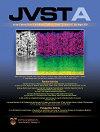Phase composition of polycrystalline HfNx (0.45 ≤ x ≤ 1.60) and effects of low-energy ion irradiation on microstructure, texture, and physical properties
IF 2.1
3区 材料科学
Q3 MATERIALS SCIENCE, COATINGS & FILMS
引用次数: 0
Abstract
We have investigated the phase composition of HfNx as a function of x and the effects of low-energy ion irradiation on the microstructure and physical properties of polycrystalline layers grown on SiO2 at 350 °C by ultrahigh vacuum reactive dc magnetron sputtering of Hf in mixed N2/Ar discharges. X-ray diffraction and Rutherford backscattering spectrometry results show that the phases obtained in polycrystalline HfNx layers with increasing x are hcp-structure α-Hf:N (x ≲ 0.6); multiphase mixtures consisting of α-Hf, NaCl-structure δ-HfN, rhombohedral ɛ-Hf3N2, and/or ζ-Hf4N3 (0.6 ≲ x ≲ 0.9); δ-HfN single phase (0.9 ≲ x ≲ 1.3); and mixtures of δ-HfN and higher nitrides (x ≳ 1.3). HfNx layers with 0.9 ≲ x ≲ 1.2 grown under mild ion irradiation (incident ion energy Ei ≃ 7 eV and ion-to-Hf flux ratios Ji/JHf = 1−3) are underdense with mixed orientation, low in-plane stress, and rough surface morphology due to limited adatom mobilities resulting in kinetic roughening and atomic shadowing during film growth. However, the use of intense ion irradiation (Ei = 25 eV and Ji/JHf = 4−20) results in HfNx layers, which are fully dense with strongly 111-oriented texture, compressive in-plane stress, and smooth surfaces due to ion irradiation enhanced adatom surface mobilities. In addition, the latter films have lower resistivity and higher hardness. For stoichiometric δ-HfN layers, ρ decreases from 69.7 to 35.2 μΩ cm and H increases from 22.1 to 27.4 GPa, with increasing ion-irradiation intensity. However, for HfNx layers with 1.2 ≲ x ≲ 1.6, the correspondingly higher steady state atomic N surface coverages during deposition alter growth kinetics in favor of 001 texture with a fully dense structure and compressive in-plane stress.多晶HfNx(0.45≤x≤1.60)的相组成及低能离子辐照对其微观结构、织构和物理性能的影响
本文研究了HfNx的物相组成随x的变化规律,以及低能离子辐照对N2/Ar混合放电中Hf在350°C下在SiO2上生长的多晶层微观结构和物理性能的影响。x射线衍射和卢瑟福后向散射光谱分析结果表明,随着x的增加,HfNx多晶层中得到的相为hcp结构α-Hf:N (x > 0.6);α-Hf、nacl结构δ-HfN、菱形体α -Hf3N2和/或ζ-Hf4N3组成的多相混合物(0.6≤x≤0.9);δ-HfN单相(0.9≤x≤1.3);δ-HfN和较高氮化物(x≥1.3)的混合物。在弱离子辐照(入射离子能量Ei≃7 eV,离子/ hf通量比Ji/JHf = 1−3)下生长的HfNx膜密度为0.9≤x≤1.2,取向混合,面内应力低,表面形貌粗糙,这是由于薄膜生长过程中原子迁移率有限导致的动力学粗化和原子阴影。然而,使用强离子辐照(Ei = 25 eV, Ji/JHf = 4−20)得到的HfNx层完全致密,具有强烈的111取向织构,面内压缩应力,由于离子辐照增强了附原子表面迁移率,表面光滑。此外,后一种薄膜具有更低的电阻率和更高的硬度。随着离子辐照强度的增加,δ-HfN化学计量层的ρ从69.7减小到35.2 μΩ cm, H从22.1增大到27.4 GPa。然而,对于1.2≤x≤1.6的HfNx层,在沉积过程中,相对较高的稳态原子N表面覆盖率改变了生长动力学,有利于具有完全致密结构和面内压缩应力的001织构。
本文章由计算机程序翻译,如有差异,请以英文原文为准。
求助全文
约1分钟内获得全文
求助全文
来源期刊

Journal of Vacuum Science & Technology A
工程技术-材料科学:膜
CiteScore
5.10
自引率
10.30%
发文量
247
审稿时长
2.1 months
期刊介绍:
Journal of Vacuum Science & Technology A publishes reports of original research, letters, and review articles that focus on fundamental scientific understanding of interfaces, surfaces, plasmas and thin films and on using this understanding to advance the state-of-the-art in various technological applications.
 求助内容:
求助内容: 应助结果提醒方式:
应助结果提醒方式:


